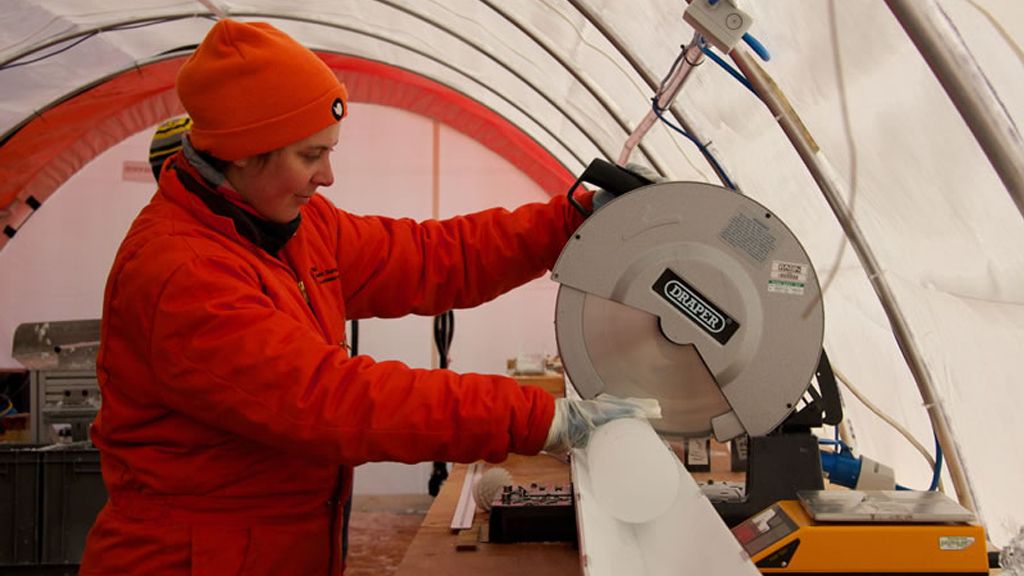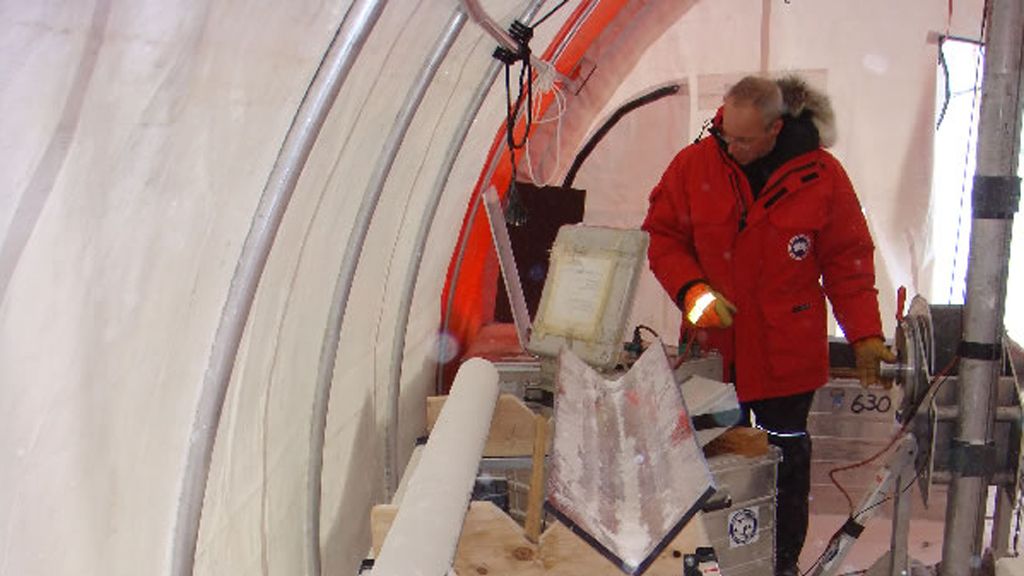15,000 years of Antarctic Peninsula climate history
Dr. Nerilie Abrams cutting a piece of the James Ross Island ice core
© JACK TREIST
Each time a new ice core is studied, the more we learn about the Earth’s climate history and how the planet’s climate system works. A team of researchers from the UK, Australia and France were recently able to extract and study an ice core taken from the ice cap covering James Ross Island off the coast of the Antarctic Peninsula.
Going back some 15,000 years – at least in the part of the ice core that has been studied – it is the first ice core record for the Antarctic Peninsula region that covers the entire Holocene (the current interglacial period that began 11,700 years ago) and includes the tail end of the last ice age.
As a research fellow at Australia National University (ANU) focusing on past climates and how the planet’s climate is changing, Dr. Nerilie Abram took part in the extraction and study of the James Ross Island ice core. In her interview with SciencePoles, Dr. Abram discusses some of the insights she and her colleagues were able to obtain from studying the wealth of paleoclimate information in the ice core.
What were your objectives in taking the ice core from James Ross Island?
We were looking to get a long climate history from the Antarctic Peninsula, as it is one of the fastest warming places on Earth at the moment. The instrumental records don’t go back that far – only about the last 50 years.
We wanted to put that recent rapid warming into a longer climate perspective to find out exactly how unusual the recent warming has been.
How unusual has the recent warming been?
The recent warming is highly unusual but not unprecedented. By highly unusual, I mean that the rate of warming along the peninsula has been in the upper 0.3% of all century-scale temperature trends over the last 2,000 years.
How did you arrive at those numbers?
We used a statistical test using the very highly resolved ice core data for the last 2,000 years of the record (something that was only possible before using climate model output, not real climate observations). We were able to calculate what the temperature trend was over 100-year time spans stepped every 1 year for the most recent 2,000 years of the ice core data. This analysis showed how the rapid warming over the last century is at the very upper limit of all century-scale warming trends in the ice core data.
Is this the first ice core in the region that goes back so far in history?
There have been a number of short cores taken from the Antarctic Peninsula, but they go back only a few hundred years at most. This is the first long core that goes back much further – as much as 50,000 years – well before the end of the last Ice Age and giving a complete history of the Holocene.
Did analysis of the ice core confirm certain theories scientists had about past climate in the region?
One of the things we were hoping to do was see if there was a connection between atmospheric temperature and ice shelf behaviour (whether they were present or not) along the Antarctic Peninsula. The ice core record showed that link very well and it made sense.
The ice core also showed that the warming along the eastern side of the Antarctic Peninsula actually started about 600 years ago – well before the Industrial Revolution. But it also showed how fast the recent warming over the past century has been. Average atmospheric temperatures on the Antarctic Peninsula have increased by around 2°C over the past 50 years. By comparison, the slow natural warming in this area from about 1400 to 1850 AD occurred at around 0.2°C per century.
The warming that was taking place in the region of the Antarctic Peninsula, was that a very local climate phenomenon? In the Northern Hemisphere, the Little Ice Age (a cooler period that lasted between the 13th century the mid-19th century) was well under way around that time.
It’s quite interesting, actually. There are some places around Antarctica where researchers have suggested that there are signatures of the Little Ice Age, such as in marine sediment records of sea surface temperature in the Bellingshausen Sea. One thing that the James Ross Island ice core shows is that the coolest time along the Antarctic Peninsula in recent history didn’t coincide with the Little Ice Age, but preceded it.
Most of the evidence for the Little Ice Age in Antarctica has been based on lake and marine sediment cores, and the resolution and dating on them is generally not as refined as in ice cores. In these cases, it is possible that a cooling anomaly in a low resolution record could have been taken as a signal that coincided with the Little Ice Age, when actually the cooling may have taken place earlier than the Northern Hemisphere Little Ice Age or have been part of a regional-scale climate event rather than a global-scale cooling.
Is it quite common for these kind of warmings and coolings to happen locally in a given region of the planet as part of natural climate variability?
Yes, it is common to have regional warmings and coolings. Natural climate variability is something that has happened in the past. The ice core helped us better understand the natural climate variability in the Antarctic Peninsula region and how recent climate change compares with natural climate changes in the past.
You mentioned in your study that around the beginning of the Holocene, there was a warming of 6°C, and that temperatures reached about 1.3°C higher than they are today before they cooled down again. Was this a temperature increase similar to what we are seeing today?
The warming coming at the beginning of the Holocene wasn’t rapid like we’re seeing today. There was a large temperature change seen all over Antarctica, going from very cold conditions during the last Ice Age to warmer conditions during the current interglacial period.
The records from all across Antarctica show that as the climate gradually warmed from the last glacial maximum to the warmer conditions during the Holocene, there was a peak in temperatures at the beginning of the Holocene. After that, temperatures cooled slightly, and then levelled out at a stable Holocene level. This is what we see on the Antarctic Peninsula as well.
Were you able to find an explanation for the peak in temperatures at the beginning of the Holocene? Were there certain climate feedbacks involved to your knowledge?
We didn’t look at any of the processes in the study we did. But this is something we want to have a look at more once we are able to refine the age model on the deeper part of the ice core even more. The whole ice core goes back as much as 50,000 years, and there is still a lot of work to be done to investigate how the Antarctic Peninsula climate behaved in comparisons to what was happening on the Antarctic mainland during the last ice age and the warming coming out of the ice age.
Would you be able to use some sediment cores as well?
There are a fairly limited number of records available around Antarctica. One of the things we’re looking at now in order to extend the past climate record even further is to understand what the glacial period was like in this area. As part of that work we will certainly draw on whatever other climate information is available to compile as complete an understanding of the past climate system as possible.
Have there been any marine sediment cores taken in the Antarctic Peninsula region that have been able to provide a more general idea of what the climate has been doing?
There was a sediment core record published last year from the western side of the Antarctic Peninsula, and that gave a more coarse resolution look at what has been happening with the ocean temperature off the coast of the peninsula over the past 10,000 years.
In addition to that, when ice shelves have collapsed along the Antarctic Peninsula (like the Larsen A and Larsen B Ice Shelves), scientists have been able to go in and collect marine sediment cores from the seabed below where the ice shelves had once stood. These cores have been able to give us a rough idea of when ice shelves existed and didn’t exist in these areas over the course of the Holocene.
You said the warming that began 600 years ago has contributed to the destabilization of the ice shelves along the Antarctic Peninsula. How much has the recent warming contributed to the collapse of ice shelves along the peninsula?
In the case of the Larsen B Ice Shelf, which collapsed in 2002, there is evidence that this had been stable all throughout the Holocene. So the collapse that happened in 2002 really was a new event for the Holocene. I think it’s quite likely that in the southern part of the Antarctic Peninsula, we’re seeing the effect of human-induced warming that’s taken the climate here beyond what normal Holocene conditions have been.
Further north of the Larsen B along the peninsula, there are indications that both the Larsen A and the Prince Gustav Ice Shelves were not present during the middle Holocene, and that these ice shelves only reformed about 2,500 years ago when the climate here began to cool. From the temperature record in the ice core we took, we can see then that the ice shelves further north on the peninsula were marginal ice shelves, and the warming that started 600 years ago started taking the temperature in that region back up to a level where both of those ice shelves wouldn’t be stable anymore.
Did the Mid-Holocene Optimum that occurred about 7,000 years ago in the Northern Hemisphere have any influence on Antarctica?
In some parts of Antarctica, there’s some evidence of a fairly mild Mid-Holocene Optimum. But we don’t see any clear evidence for it on the Antarctic Peninsula. The higher temperatures we saw on the peninsula during the Early Holocene Optimum came down and stabilised about 9,000 years ago, and then remained very steady until about 2,500 years ago. After that, the climate began to cool until about 600 years ago, before it started to warm up again to today’s temperatures.
Was the warming that began in the Antarctic Peninsula region 600 years ago primarily due to natural variability?
It has to be due at least partly to natural variability, because 600 years ago was well before the start of the Industrial Revolution. It is possible that the rapid warming we’ve been seeing along the Antarctic Peninsula over the past century is a combination of this natural climate cycle and human-induced warming.
What kind of research still needs to be done in this region? What sort of things would you like to find out?
There are two areas where we’re going with the ice core:
One is to get a much better understanding of the deeper part of the ice core, as I mentioned before. We need to have a better idea of what was happening during the very end of the last ice age, because this is the first ice core record we have from the Antarctic Peninsula that goes back as far as the last glaciation.
The other thing is to investigate in greater detail what the ice core is telling us about the past 2,000 years so we can get a better idea of what processes were happening and trying to distinguish between the role of natural and human influences on the climate in this part of Antarctica.
How does the record from the James Ross Island ice core match up with other ice cores from around Antarctica in terms of climate history?
The large-scale features are broadly similar to what we’ve seen in other ice cores from the main Antarctic continent. But during the last ice age, it wasn’t as cold on the Antarctic Peninsula as it was elsewhere on the continent. We expected to see this. The peninsula is further north than where the other continental records have come from and it has a milder climate due to the strong influence of the surrounding seas.
The Early Holocene Optimum looks fairly similar to what we’ve seen in ice cores from other parts of Antarctica. But the warming that’s been going on over the last 600 years seems to be a signal that’s confined to the eastern side of the Antarctic Peninsula, rather than an Antarctica-wide signal.
Is it possible to make any projections for the climate in the Antarctic Peninsula region based on data that’s currently available?
That’s beyond my area of expertise. A modeller would have to take the data we’ve put together and review it alongside climate models for the region. The data we’ve collected will help the experts to determine what processes are causing warming.
For example, the ozone hole over Antarctica was thought to be one reason why the Antarctic Peninsula has been warming so quickly. But actually the ice core data shows that the rapid warming in the region started in the 1920s. That’s probably too early for the ozone hole to have been the sole driver of the rapid warming in the region.
So the ice core data we’ve collected can help test hypotheses for what drives climate processes in this area, which can help the modellers with their projections of what the climate might be like in the future.
Isn’t there research indicating that the ozone hole over Antarctica is influencing atmospheric circulation above the continent and allowing conditions to remain cooler over Antarctica?
That’s what the ozone hole is believed to do over central Antarctica. The ozone hole strengthens the westerly winds that circulate around Antarctica, and this causes the main Antarctic continent to be more isolated from warmer air masses coming in from the Southern Ocean. But because the Antarctic Peninsula juts out into that westerly wind band, the stronger winds actually cause warming on the Antarctic Peninsula, while leading to cooling and thermal isolation on the central Antarctic Plateau.

Nerilie Abram
Nerilie Abram is a QEII Research Fellow at Australian National University's College of Physical and Mathematical Sciences. She spent seven years at the British Antarctic Survey, where she took part in the James Ross Island ice coring project. Dr. Abram continues her work on paleocliamte research, moving from paleoclimates in Antarctica to paleoclimates in the tropics.





